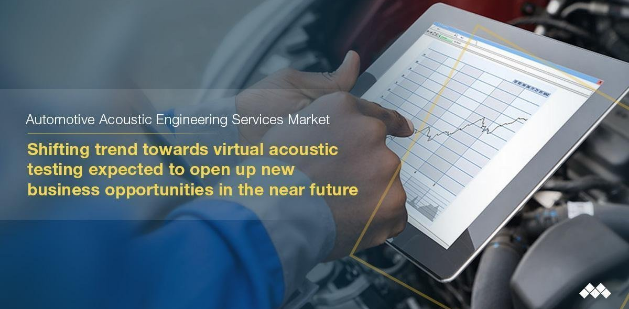
The Automotive Acoustic Engineering Services Market is projected to grow at a CAGR of 7.42% during the forecast period from 2018 to 2025, to reach a market size of $4.04 billion by 2025. Growing stringency of norms regarding vehicle noise levels, robust demand for premium vehicles, increasing focus towards engine downsizing and vehicle light-weighting, reduction of R&D expenses, and less product development time are the key factors that fuel the demand for acoustic engineering services.
The automotive acoustic engineering services include processes such as designing, development, testing, and simulation of sound originating from the engine, transmission, other auto components, and overall vehicle to bring the interior cabin noise within the permissible range. These processes usually measure the pass-by noise and stationary noise to achieve a satisfactory result for the vehicle. Acoustic engineering and testing services are carried out for different applications such as the powertrain, drivetrain, body interior, and exterior to control and minimize the noise level of the vehicle.
Some prominent players of automotive acoustic engineering services market are AVL (Austria), Siemens PLM (US), Bertrandt (Germany), Schaeffler (Germany), EDAG Engineering (Germany), Continental (Germany), FEV (Germany), Autoneum (Switzerland), and IAV (Germany).
Download PDF Brochure @ https://www.marketsandmarkets.com/pdfdownloadNew.asp?id=45379651
Simulation software is projected to be the largest and fastest-growing market during the review period. The main advantages associated with simulation are enhanced acoustical testing & measurement, reduced R&D cost, multiple testing options, and reduced development time. Also, the introduction of artificial intelligence in simulation helps to understand the actual behaviour of a component in the most appropriate manner. Engineering service providers such as Siemens, AVL, Schaeffler, Bertrandt, and IAV provide simulation services for automotive components and vehicle assembly. Thus, a continuous increase in R&D activities and the rising need for process optimization have led to improvements in simulation. Improved simulation software has become a prime requirement that would drive the demand for simulation software in the coming years.
Designing is the most important process in which multiple prototypes can be developed and tested virtually by using simulations and integrations in the vehicle, and each prototype is evaluated against the desired noise limit. In this process, the noise from the engine, wheels, motor, and tires etc. can be monitored. This process helps decide the material that can be used for component manufacturing to control the noise. Thus, it ensures that the vehicle and the component get optimum acoustical accuracy and helps proceed with the development of the actual product. The current and upcoming safety norms and technological advancements would continue to make a vehicle design more complex in the future. The designing process would remain a key focus in automotive acoustic engineering services to avoid new launch delays and reduce cost.
The acoustic engineering services market for electric & hybrid vehicles is expected to grow at the fastest rate from 2018 to 2025. The presence of an alternate powertrain brings new sources of noise such as the motor, HVAC, battery, tires, and several other low decibels (dB(A)) noise from brake, acoustics, wind, squeaks, and rattle sounds from the vehicle that needs to be addressed to improve the acoustical performance. Further, new legislative guidelines for electric and hybrid vehicles with respect to minimum noise requirement have changed the dynamics of acoustic engineering of these vehicles. As defined by NHTSA laws published in January 2013, electric & hybrid vehicles must have a minimum exterior sound requirement of 63.8 to 68.9 dB(A) while running at a speed of 30 kmph. This sound should be loud enough to be audible to a visually impaired person when the vehicle passes nearby. Hence, the vehicular noise refinement and the minimum sound requirement by the legal authorities would drive the electric and hybrid vehicle acoustic engineering services market.
Request FREE Sample Report @ https://www.marketsandmarkets.com/requestsampleNew.asp?id=45379651
Target Audience:
1. Automotive acoustic simulation service providers
2. Automotive acoustic testing & engineering services providers
3. Acoustic testing equipment suppliers
4. Automotive Original Equipment Manufacturers (OEMs)
5. Regional manufacturing associations and automobile associations
6. Regional vehicle noise regulatory authorities
7. Tier-I component/system manufacturers
Media Contact
Company Name: MarketsandMarkets
Contact Person: Mr. Aashish Mehra
Email: Send Email
Phone: 18886006441
Address:630 Dundee Road Suite 430
City: Northbrook
State: IL 60062
Country: United States
Website: https://www.marketsandmarkets.com/Market-Reports/automotive-acoustic-engineering-service-market-45379651.html
